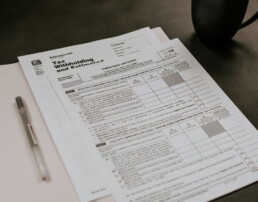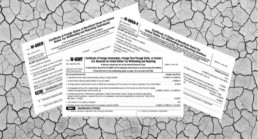Ross McGill
Your W-8 Questions Answered
In our last blog about W-8 forms, we talked a bit about what they are and what they’re used for. We got a lot of questions about W-8 forms off the back of that post, so today I thought it would be a good idea to gather some of them together and answer them. I promise I’ll do my best to not answer each one with ‘it depends’!
If you need an update on the basics of a W-8, click here to read the last article. Otherwise, let’s get into it.
Who Needs to Complete W-8 Forms?
Any non-US investor trying to open an account with a broker or a custodian bank will almost certainly be asked to provide a W-8 (or a W-9 if they’re American). The institution will ask you to fill one in or collect the information they need from their website (called a substitute W-8).
Which Countries Have Double Tax Treaties with The US?
This is a tricky one because double-tax treaties are changing all the time. However, I can tell you that at the time of writing, there are approximately 65 countries that have a tax treaty with the US. Get ready for a long list, because that includes:
- Armenia
- Australia
- Austria
- Azerbaijan
- Bangladesh
- Barbados
- Belarus
- Bulgaria
- Canada
- Chile
- China
- Cyprus
- Czech Republic
- Denmark
- Egypt
- Estonia
- Finland
- France
- Georgia
- Germany
- Greece
- Iceland
- India
- Indonesia
- Ireland
- Israel
- Italy
- Jamaica
- Japan
- Kazakhstan
- Korea
- Kyrgyzstan
- Latvia
- Lithuania
- Luxembourg
- Malta
- Mexico
- Moldova
- Morocco
- Netherlands
- New Zealand
- Norway
- Pakistan
- Philippines
- Poland
- Portugal
- Romania
- Russia
- Slovak Republic
- Slovenia
- South Africa
- Spain
- Sri Lanka
- Sweden
- Switzerland
- Tajikistan
- Thailand
- Trinidad
- Tunisia
- Turkey
- Turkmenistan
- Ukraine
- Venezuela
- United Kingdom
- Uzbekistan
When And Where to Submit Your W-8
No one submits their W-8 or W-8BENEs directly to the IRS. Instead, you send them back to the institution that requested it. They will then be used by the institution to decide whether to let you open an account, how to treat and tax US investment income paid to your account and whether your account is reportable under US anti-tax evasion regulations.
What’s The Difference Between W-8 And W-9 Forms?
Just to add in another issue, there’s also a W-9 form. Thankfully, it’s easy to differentiate the two.
W-8 forms are for non-residents of the US only. That includes international students, who will need to file a W-8BEN where necessary.
W-9 forms are for citizens and residents of the US. So if you’re a US resident for tax purposes, then you’ll need to provide a W-9.
How Long is a W-8BEN Valid For?
It does depend (sorry).
Provided none of the details on the form change, your W-8BEN will be valid for three calendar years from the end of the year in which you sign it. So, if you completed the form on the 28th of March 2024, it will be valid until the 31st of December 2027.
There is another quirk of the system, but it shouldn’t affect you. Your financial institution is collecting these W-8s to document your tax status under two different “chapters” of the US Internal Revenue Code – Chapter 3 and Chapter 4. The quirk is that if your financial institution is only collecting the W-8 solely to document your Chapter 4 status, then the form is valid indefinitely or until you have a change in circumstances. The three-year validity rule only applies if you’re expecting to receive US investment income into your account, so the financial institution needs to know your Chapter 3 status too.
What’s The Difference Between a W-8BEN and a W-8BENE?
There are a few differences between the W-8BEN and the W-8BENE. The main one is that the W-8BENE is the form for ‘entities’, meaning any type of business or other type of institution that has more than one owner. That could be a corporation, certain types of partnership or trust, exempt entity, public and private foundations, international organisations and even foreign governments.
The default US tax rate for income received by foreign businesses is 30%, but this form will allow the business to receive a tax treaty reduction if it’s applicable and if it’s properly claimed on the form. In particular, the entity has to make a certification on the form to show that it meets what is called the limitation on benefits test.
The W-8BEN on the other hand, applies to income paid to individuals. So while the outcome is similar, the forms are aimed at different categories of people and types of account holders.
We went over these differences in more detail here.
What Happens If I Fill in the Form Incorrectly?
There are estimated to be around 900 million W-8s in circulation and about 30% are completed incorrectly in Europe. That failure rate rises to about 70% in Asia. That’s because it’s an American tax form, it’s not simple and it’s not written in plain English. Differences in language, culture and levels of understanding can affect whether you understand what you’re signing.
The big thing to recognise is that the form is signed under penalty of perjury. This means that if you fill the form in incorrectly, whether that’s deliberate or accidental, and your financial institution taxes your US income at the wrong rate, you’re the one on the hook for liability, not them.
In the end, most financial institutions are very conservative. If there is any doubt, they will tax at the maximum rate of 30%. That means that you may be over-taxed through no fault of your own. In such cases, if your financial institution is a qualified intermediary (QI), then you can ask them for a refund because their contractual agreement with the IRS obligates them to do so. If they are not a QI, then you can, in theory, file a claim directly to the IRS for a refund. The process is not simple or quick and you’ll need to ask your financial institution for a form 1042-S to prove that they over-taxed you. Then, if you’re an individual, you can file a claim on a form 1040-NR together with your 1042-S (and other supporting evidence). If you’re filing a reclaim request for an entity that was over-taxed, the form will be an 1120-F.
Who Can Help Me?
Us! At TConsult we have over 20 years’ experience in the financial services industry, particularly dealing with US withholding tax and all that comes with it. Our subject matter experts have detailed knowledge of the governments and financial institutions in over twenty-seven countries, making us perfectly placed to handle your W-8 questions and support you through the process.
We created an online platform for W-8 forms to be used by financial institutions. So, if you work for a financial institution that provides access to the US securities markets, you should get a demonstration of our Investor Self-Declaration (ISD) system. This collects all the required information for a substitute of all the W-8 forms or W-9 and makes sure that you don’t make any mistakes.
If you would like to know more, or if you’re a financial institution struggling with compliance, or you have questions about a W-8, W-8BEN or W-8BENE, just get in touch with one of our experts today.
Articles
Gain deeper insight with articles that give our considered opinion and predictions of where the industry will go next.
Muinmos and TConsult ink deal over digital investor tax self-declarations
Muinmos and TConsult have signed an agreement to integrate TConsult’s Investor Self-Declaration platform (ISD) into Muinmos’ Client Onboarding Platform, enabling Muinmos’ clients, typically financial institutions, to automatically obtain ISDs instead of using multiple paper tax certification forms to document the tax status of their clients.
3 Big Problems with US Tax Regulations
We explore some of the problems we have encountered surrounding the use of Form W-8BEN-E by brokerages and issuers of equity linked instruments.
Nationality, domicile, residency, citizenship and beneficial ownership
We often find that linguistic issues can cause problems for firms looking to establish the correct withholding rate for their clients. In particular, we have seen the distinctions between nationality, citizenship, domicile, residency and beneficial ownership cause a degree of avoidable consternation. In this post, we present a quick reference guide.
Validating W-8 Forms: Cultivating an Eye for Detail
We are often asked what constitutes a consequential or an inconsequential error when validating a W-8 form. Some errors are obviously consequential, but what happens if an error appears relatively trivial, such as an incorrect date format? In this post, we explore how you can assess the risks involved and make a judgement about whether to reject or validate a W-8 form.
Why W8? – Start re-papering over the cracks now!
QIs and NQIs face a rare opportunity to dramatically increase their W-8 compliance rate by re-papering all existing clients using the IRS' new W-8 forms. Find out how such a project could benefit your firm and why it could be worth it in the long run.

W-8 – W-8驗證的險境
April 2, 2024美國的稅收制度是世界上最大的制度之一,意味著其變動將會對更廣大的市場帶來連鎖反應。FATCA是近期史上最大的變革之一,且對其他稅務市場的運作造成許多根本性的改變。特別是,確保金融機構需要使用一些美國W-8系列表單來收集客戶的FATCA(美國稅務)狀態訊息。 W-8系列表單是美國國稅局(IRS)不定時更新的紙本表單,有以下幾種類型: W-8BEN 給個人使用 W-8BENE 給實體與某些類型的信託使用 W-8ECI 給與美國商業貿易有效連結所得的客戶使用 W-8EXP 給政府或國際機構客戶使用 W-8IMY 給中介機構或某些類型的稅務透明信託使用 W-8表單為IRS做了一些事,任何時候有大約9億份W-8表單在流通。它們都有一個共通點 – 需要被驗證。 W-8有什麼作用 W-8表單涉及美國國內稅收法(或IRC) – 第4章(FATCA)與第3章(QI/NQI). 我特別按次順序說明,因為那是IRS法規要求遵循的盡職調查與驗證法規。這兩章都有對支付給客戶的美國來源FDAP所得課徵稅款的可能性。在第4章中稅率是30%,而第3章下稅率為30%或較低的租稅優惠協定稅率。這些法規基於非重複徵稅原則(亦即,如果第4章中有預扣稅款,則第三章無需預扣稅)。如果在第4章沒有需要預扣的稅款,那麼在第3章中的預扣稅款則依據W-8所聲明的正確稅率預扣 […]Read more

The FASTER Directive Is Coming Up Fast – Are You Ready?
April 4, 2024By now, many of you should have heard about a new proposed EU Directive called FASTER. It stands for Faster […]Read more

Why Am I Being Asked For a W-8?
April 11, 2024One of the most common questions I hear from investors is ‘why am I being asked for a W-8’? It’s […]Read more

什麼是曝險地圖報告?
April 18, 2024如果您需要問這個問題,那麼您可能需要一份。 在TConsult,我們與金融機構和稅務監管機關合作了20幾年,這意味著我們幾乎已經看過這一切,並做到了這一切。在過去的幾年裡,我們開發了一項曝險地圖報告(Exposure Map Report)的產品,幫助金融機構瞭解他們的風險和責任所在,以及他們需要做些什麼來應對這些風險和責任。今天,我們就來解釋一下這到底是什麼。 什麼是曝險地圖報告(Exposure Map Report)? 本質上,它是對金融公司受某些跨境稅務法規影響的分析報告。這是一種快速、簡單、無痛的方法,可以確定您是否在做正確的事情。我們會研究貴公司的機構和現狀,然後根據可能對貴公司產生影響的法規進行對照。 曝險地圖報告通常先決定報告要解決的問題。我們的報告可以涵蓋廣泛的法規,但最受歡迎的(絕大多數)是美國預扣稅。我們還涵蓋: FATCA/CRS DAC6 TRACE GDPR DORA FASTER BEPS 我們從一份簡單的調查問卷開始,收集有關貴公司及其獨特情況的大量資訊,從而瞭解貴公司可能面臨的問題。然後,我們將這些資訊與貴公司承擔的監管和合約義務相對照(因此得名),並找出貴公司在哪些方面不合規,或在哪些方面可以提高合規性或運營效率。然後,我們將報告交付給您,並安排一次EMR後電話會議,以澄清您感到困惑、需要更多資訊或有疑問的地方。 曝險地圖報告通常還能解決一些您可能完全忽略更技術性的問題。在與IRS打交道時,您將使用以下平台和入口網站與他們溝通: FIRE (1042-S) […]Read more

What Is An Exposure Map?
April 18, 2024If you need to ask that question, then you probably need one. At TConsult we’ve been working with financial institutions […]Read more


How To Stay CRS Compliant
May 15, 2024CRS, otherwise known as the Common Reporting Standard, is a set of rules and technical reporting requirements that form the […]Read more

We are hiring!
May 16, 2024We are looking for a new person to join our team delivering compliance support to our growing client base. Could you be our next up-and-coming consultant?Read more

究竟什麼是修訂申報?
May 23, 2024現在已經是五月下旬了,這意味著您應該已經使用IRS的電子資訊申報(Filing Information Returns Electronically, FIRE)入口網站提交了原始的1042-S資訊申報表。您可能會拍拍自己的後背,翹起二郎腿,認為今年的任務已經完成。 嗯,不一定。 有些投資工具可以在美國納稅年度結束(12月31日)後改變分配所得的分類。美國共同基金和圖動產投資信託(又稱REITs)就是兩個很好的例子。這些投資工具通常會告知支付鏈的頂端。例如,它們可能會說,去年原本被歸類為股利的分配,現在被重新分類為資本收益。這不僅令人討厭,而且還意味著一些在支付鏈下游創建的1042-S表格(然後發放給IRS和收款人)現在是錯誤的。 現在怎麼辦? 重分類有什麼影響? 如果發生這種情況(且確實發生了),那麼您需要採取一些措施。因為現在,如果您是一名 QI,那麼您的集合申報(pooled reporting)可能不再正確。總金額不會有任何變化,但與付款相關的所得代碼(也許還有稅率)會發生變化。例如,您原來的30%股利集合(所得代碼 6)可能需要減少,而您的資本收益集合(所得代碼 37)可能需要增加。如果您一開始就沒有代碼37的集合,那麼您可能會因為現在申報的新集合而被處以逾期申報罰款,因為它不在最初的申報中。 如果您的申報是集合式,那麼只有集合應該被影響。如果您因為客戶是金融機構或穿透實體(flow-through entity),或者因為揭露式NQI向您揭露了間接收款人,而不得不簽發收款人副本,那麼其中一些收款人副本現在可能也出錯。 您可能還會發現,有些客戶投資了不止一種重分類其所得的工具,而您不太可能同時發現這些情況。如果是這種情況,您可能需要提交多份修訂檔。1042-S的頂端(以及IRS檔案的檔案規格)允許您在提交多份修訂時詳細說明提交的修訂數量。這可能會引起混淆,這也是許多公司等待並只提交一套修訂檔的原因之一。但不要忘記,如果您延遲申報,您的交易對手可能會受到影響,如果他們的下游客戶需要知道的話。在這個例子中,股利可能被徵收30%或15%的稅,但資本收益不被課稅。因此,如果您因這種重分類而修改報稅表,您需要記住,您可能會通過1042報稅表要求IRS退稅,以平衡帳目。 如果我揭露了客戶資訊該怎麼辦? 如果您是揭露式NQI,好消息是您不必擔心。揭露行為會將任何報告義務(包括修訂)賦予您的交易對手,而交易對手通常是一家QI。他們應直接收集並向您的客戶發送修改內容,或者如果您與他們有商議過,則應將修改內容轉發給您。 然而,如果您是非揭露式NQI,那麼您所承擔的義務與QI幾乎相同,但沒有可以集合申報的好處。這意味著您需要花時間找出哪些特定客戶收到了所得,向國稅局提交修訂檔,並簽發新的收款人副本。這可能是一項非常繁重的工作。 […]Read more

What Is Amended Reporting Anyway?
May 23, 2024Well, we’re in late May now, which means you should have submitted your original 1042-S information returns filing using the […]Read more
Ross is the founder and chairman of TConsult. He has spent over 26 years working in the withholding tax landscape with companies developing tax reclaim software and operating outsource tax reclamation services.
Ross not only sees the big picture but is also incredibly detail oriented. He can make even the most complex issues simple to understand. He has authored 10 books (including two second editions) on various aspects of tax, technology, and regulation in financial services, making him one of the leading authorities in the world of tax.









